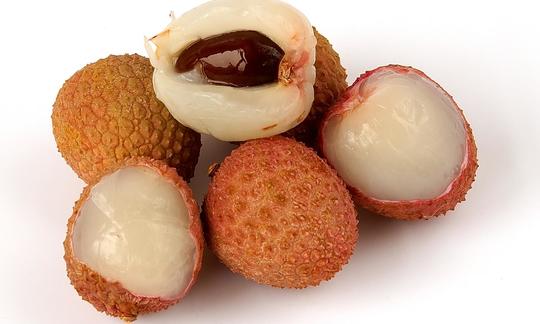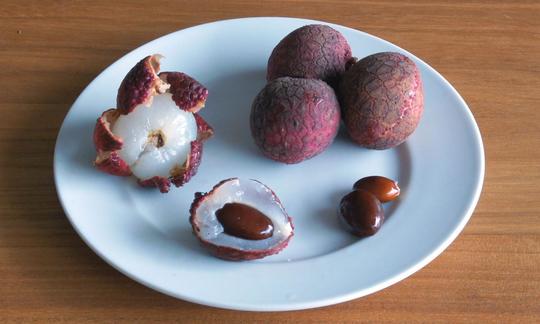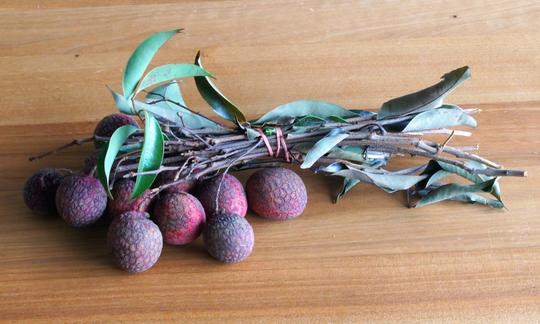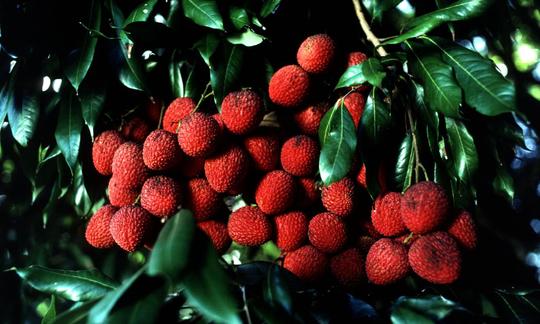Table of contents
Lychees ( Litchi chinensis Sonn.) are considered a symbol of love in southern China. They have a sweet and sour taste when raw. Make sure they are organic.
Use in the kitchen
How do you eat lychees? Lychees have a pink to dark red, knobbly skin. This is not edible. However, it can be easily removed. The flesh is white to transparent. Inside there is a core, which is also inedible. The fruit is either eaten fresh as a raw food or processed into preserves, jam, dried fruit, wine and juice. Processing extends the shelf life and meets market demand. 3
What does lychee taste like? It tastes very sweet, slightly sour and has a slightly bitter aftertaste. The smell is reminiscent of roses.
The fruit can be found in fruit salads and hearty salads (such as lychee and herb salad). It is used in (non-alcoholic) cocktails as a decoration or because of its aroma. Here it is particularly popular in combination with mint, pineapple orraspberries. In Asian cuisine, the fruit is used to make a sauce and eaten with rice, vegetables (e.g. bell peppers, broccoli, carrots) or tofu dishes. Lychees are suitable for use in curries (e.g. coconut lychee curry) as they go well with the coconut milk and curry powder. To avoid getting tough lychees, you should only cook them for a short time. Lychees are also often used in desserts such as pudding (e.g. coconut lychee pudding) or ice cream/sorbet (e.g. lychee sorbet with baked bananas). For desserts, the combination with mango, passion fruit, bananas or roses/ rose water is very popular. In addition to fresh lychees, they are also available in canned form. However, these contain fewer vitamins, more sugar and are no longer considered raw. Fresh lychees are therefore preferable during their season. When consuming canned lychees, rinse them well before eating to wash off the excess sugar juice.
Vegan recipe for lychee ceviche
Ingredients (for 2 people): 20 lychees, 0.5 tsp agave syrup, 1 lemon (2 tsp lemon juice), 1 red onion, ginger, mint (4 stalks), salt, chili flakes.
Preparation: Peel the lychees and remove the stone. Then halve them. Squeeze the lemon and cut the onion into thin slices. Finely chop the mint. Put the lychees, agave syrup, 2 teaspoons of lemon juice, onion and mint in a bowl and grate some ginger into the mixture. Mix everything together and season with salt and chili.
Vegan recipes with lychee (raw) can be found under the note: " Recipes that have the most of this ingredient ".
| Not only vegans or vegetarians should read this: Vegans often eat unhealthily. Avoidable nutritional errors. |
Purchasing - Storage
Lychees are available in conventional and organic quality during their season in supermarkets (such as Coop, Migros, Spar, Aldi, Lidl, Rewe, Edeka, Hofer, Billa). Some well-stocked supermarkets sell them all year round. They can also be found in season in organic supermarkets (such as Denn's Biomarkt and Alnatura). The fruit is available at smaller supermarket chains such as Denner and Volg during selected promotions.
In Central Europe, lychees are often imported from South Africa and Madagascar, both of which are in the southern hemisphere. Therefore, the main season for lychees is from November to March. In the summer months of July and August, supermarkets offer lychees from Israel. The canned fruits are available all year round. The freshness and optimal ripeness of the lychee can be recognized by a pink/red skin that is plump and undamaged. It feels a little firm and has a delicate, pleasant scent. Lychees do not ripen further, which is why it is best to buy them fully ripe. Unripe fruits can be recognized by a yellow-green skin and overripe fruits by a dark skin.
The availability of lychees varies depending on the size of the store, catchment area, etc. Our recorded food prices for the DA-CH countries can be found above under the ingredient image - and by clicking you can see their development at different suppliers.
Storage tips
Ripe lychees spoil in a few days at room temperature. Therefore, you should use them as quickly as possible. In the fridge they will last for about 7 days, but they will lose some of their flavour. Alternatively, you can freeze lychees. To do this, remove the skin and the stone. Frozen lychees will keep for up to 12 months.
Ingredients - Nutritional values - Calories
What nutritional values does the lychee have? Raw lychees contain 66 kcal per 100 g. The average weight of a lychee is 8 g, which gives you around 5 kcal per piece. The macronutrients are divided into 17 g carbohydrates, 0.83 g protein and 0.44 g fat per 100 g lychee fruit. The 17 g carbohydrates in the lychee consist of 15 g sugar and 1.3 g fiber. 1
The lychee fruit contains an average of 72 mg of vitamin C (ascorbic acid) per 100 g, which corresponds to 89% of the daily requirement. Green papaya (75 mg/100 g) and the American persimmon (66 mg/100 g) provide a comparable amount. The real guava contains 228 mg per 100 g, which is about three times as much vitamin C. 1
Lychees have 171 mg of potassium per 100 g. This corresponds to 9% of the daily requirement. This content is comparable to that of raw mango (168 mg/100g) and raw mandarin (166 mg/100g). Spinach contains 558 mg/100g, about three times as much potassium. Foods that provide the most potassium are often spices or herbs (eg dried parsley : 2683 mg/100g). However, only small amounts of these are consumed. 1
The folate content (as a folic acid-active substance group) of lychees is 14 µg per 100 g, which covers 7% of the daily requirement. Passion fruit and cinnamon apple also contain 14 µg/100g of folate, whereas raw spinach contains about 14 times as much folate at 194 µg/100g. 1
The complete ingredients of lychee (raw), the coverage of the daily requirement and comparison values with other ingredients can be found in our nutrient tables. In the article Nutrients explained you will get a detailed insight into the topic.
Health effects
Are lychees healthy? Both in vitro and in vivo studies have shown that lychees have antioxidant, hypoglycemic, hepatoprotective, hypolipidemic and anti-obesity effects. They are also considered anti-cancer, anti-atherosclerotic, hypotensive, neuroprotective and immunomodulatory. The health-promoting properties are attributed to the wide range of nutritional components. The polysaccharides and polyphenols contained in them in particular contribute to the positive properties. Polysaccharides are related to the antioxidant effect by increasing the activity of antioxidant enzymes. The hypoglycemic effect of the polysaccharides is based on a reduction in blood sugar levels and an improvement in glucose tolerance. 3
Secondary plant substances
Many of the health effects of lychees can be attributed to the secondary plant substances they contain. Our article on secondary plant substances provides an overview of the classification of substance groups, their occurrence in foods and possible effects on humans. Lychees contain the following secondary plant substances: These include polyphenols such as flavonoids, anthocyanins, triterpenes and lignans. The largest proportion is flavanols, flavanols and flavanones. Sesquiterpenes, coumarin, sterols and phenols are also found. 2,3
Dangers - Intolerances - Side effects
Lychees contain the allergen profilin. Consumption can cause severe anaphylactic reactions in people who are sensitized to profilin. 5 In addition, the lychee fruit can trigger a contact allergy, itching, urticaria and diarrhea. 2,6 Some studies also suspect a cross-reaction with latex or birch pollen. However, little is known about the allergic potential of lychees. 6
Folk medicine - natural medicine
In ancient Chinese medicine, lychee seeds were used to treat hernias, orchitis, ulcers and intestinal problems. Lychee seeds were also used to treat diabetes symptoms such as thirst. Today, approved Chinese medicines for diabetes sometimes contain lychee seeds for treatment. 7 In the Ming Dynasty, the fruit pulp was said to improve the senses and intelligence. Lychee peel was used to cure eczema, among other things. 11 In traditional Chinese medicine, lychees have also been used for centuries to treat stomach ulcers, coughs, dyspepsia and to kill intestinal worms. 3
Ecological footprint - animal welfare
The ecological footprint of the lychee is made up of the carbon emissions from its entire life cycle. The sources of CO 2 emissions include fertilizers, pesticides, agricultural activities during cultivation, electricity consumption of the cooling units, fuel for transport and distribution, as well as food losses and waste disposal. The following values represent the CO 2 equivalent of the lychee after cultivation. In addition, the CO 2 footprint of the lychees changes depending on the cold chain. Cooling the lychee from the time of harvest results in the lowest CO 2 equivalent at 0.38 kg CO 2 eq/kg. At room temperature this amounts to 0.58 kg CO 2 eq/kg, if the cold chain is interrupted at the end this amounts to 0.46 kg CO 2 eq/kg and if it is interrupted at the beginning this amounts to 0.39 kg CO 2 eq/kg. 9 The different values can be explained by the high food losses that can occur due to inadequate cooling. 9
For detailed explanations of various sustainability indicators (such as ecological footprint, CO2 footprint, water footprint), see our article: What does the ecological footprint mean?.
Worldwide occurrence - cultivation
Where do lychees come from? The origin of the lychee is believed to be in southern China. Some sources also say that it originated on the Philippine Islands. Lychees have been cultivated in China for around 40 centuries. From there it spread to Myanmar in the 17th century and 100 years later to India. It reached Madagascar and Mauritius in 1870. A Chinese trader introduced the lychee to Hawaii in 1873. It was introduced to California at the end of the 19th century. In the middle of the 20th century in Australia and Israel. Today it grows in Central and South America, in parts of Africa and Asia. The main growing countries are China, India, South Africa, Australia, Mauritius, Madagascar and Thailand. 4
Lychee ( Litchi chinensis Sonn.) includes various subspecies such as L. chinensis ssp. chinensis, L. chinensis ssp. philippinenis Leenh and L. chinensis ssp. javensis Leenh. However, only L. chinensis ssp. chinensis is used for cultivation. Different lychee varieties are cultivated depending on the country of cultivation. 10
Cultivation - Harvest
The basic requirement for the lychee to thrive is a warm subtropical to tropical climate. 4 The lychee tree is evergreen and grows to a height of 10-20 m. Lychees need between 80 and 112 days to fully ripen. The exact number depends on the variety and the weather. During fruit development, the color of the skin changes from green to reddish-pink. The color change can be attributed to a breakdown of chlorophyll and an increase in anthocyanins. After harvest, lychees do not ripen and only produce small amounts of ethylene (ripening gas). They are not climacteric fruits. 10
Lychees are very sensitive, which is why minimal stress and rapid transport and consumption are preferable. After harvesting, the fruits are sorted into boxes with green leaves as cushioning material and transported to wholesale and retail markets. Ideally, the fruits are shipped on the day of harvest. Research is currently being carried out into the ideal way to handle lychees after harvesting. Initial results show that the optimal storage temperature is 5-10 °C and that a modified atmosphere of 3-5% O 2 and CO 2 has advantages. The shelf life of lychees at room temperature (26 °C in the countries where they are grown) is less than 72 hours; after 48 hours, a drop in water content of 40% can sometimes be detected. In addition, browning of the skin can occur after harvesting. Post-harvest losses of lychees are estimated at 20-50%. 4
Further information
The lychee ( Litchi chinensis Sonn.) belongs to the soapberry family (Sapindaceae). The lychee fruit is a valuable international commodity and is an important commercial fruit crop in many parts of the world. However, its very perishable nature limits its marketing in many countries without good storage facilities. In addition, perishability poses a serious problem during transportation. 4
Is there a fruit similar to the lychee? The rambutan is similar in taste and appearance to the lychee. It also belongs to the soapberry family. 10 It is therefore also called the false lychee.
Alternative names
The Latin synonym is Litchi chinensis Sonn. 4 Alternative names for lychee are lychee fruit, lychee plum or love fruit. Another alternative name is lychee or litchi. In the past it was also called Chinese hazelnut. The English name for lychee is lychee. In German, lychee is also sometimes used as a synonym.
Other uses
Lychees are used in the food, medicine, cosmetics, pharmaceutical and chemical industries. 3 In the cosmetics industry, lychee extracts and oils are used in skin care products such as lotions and face masks. In China, it is considered a love fruit.














Comments